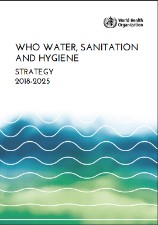WHO Water, Sanitation and Hygiene. Strategy 2018‑2025
 |
guide Mar 2018 ; 64 pages
Ed. WHO - Genève
Téléchargeable sous format: PdF
Téléchargeable chez l'éditeur
Page de présentation d'un éditeur
Résumé:
Cette stratégie définit l'orientation et le rôle de l'OMS dans le contexte des ODD et du 13ème programme de travail de l'OMS. Il renforce le rôle traditionnel de l'OMS en tant que source de directives de référence, d'assistance technique et de documentation pour l'élaboration des politiques. Il décrit comment l'OMS augmentera son impact en introduisant des approches transformationnelles et en s'attaquant à de nouveaux domaines de résultats comme dans le secteur WASH dans les établissements de soins de santé. Abstract:
This strategy sets out the direction and role of WHO within the context of the SDGs and WHO’s 13th Programme of Work. It reinforces WHO’s traditional role as a source of authoritative guidelines, technical assistance, and evidence for policy-making. It describes how WHO will increase its impact through introduction of transformational approaches, and tackling new results areas like WASH in health care facilities. Contents:
List of Acronyms
1. RATIONALE AND CONTEXT
1.1 Introduction
1.2 WASH and health
1.3 WHO and WASH
1.4 The need for transformation
1.4.1 The SDGs, WHO and WASH
1.4.2 Strengthening inter-sectoral and cross programme collaboration
1.4.3 Increasing WHO impact
2. THE WHO WASH STRATEGY
2.1 WHO strategic plan for WASH: 2018-2025
2.1.1 Strategic approaches 2018–2025
2.1.2 Priority intervention areas 2018–2025
2.1.3 WASH objectives within the WHO Global Programme of Work 2019-2023
2.2 Delivering WASH through this strategy
2.2.1 Resourcing the work
2.2.2 Investment case
2.2.3 Value for money
2.2.4 Strengthening impacts of the work
2.2.5 Monitoring and measuring progress
3. WHO WASH PRIORITY INTERVENTION AREAS
3.1 Drinking-water and recreational water quality and safety
3.2 Sanitation and wastewater
3.3 WASH in health care facilities (HCF)
3.4 UN-Water Global Analysis and Assessment of Sanitation and Drinking-Water (GLAAS)
3.5 The WHO/UNICEF Joint Monitoring Programme (JMP)
3.6 Estimation of burden of disease from inadequate WASH
3.7 WASH and health programme linkages
3.7.1 WASH and cholera
3.7.2 WASH and emergencies
3.7.3 WASH and neglected tropical diseases (NTDs)
3.8 WASH and emerging issues
3.8.1 WASH and antimicrobial resistance (AMR)
3.8.2 WASH and climate change
3.8.3 Water resources and health
4. APPENDICES
Appendix A. WHO Theory of Change for WASH
Appendix B. PHE outputs and indicators for WASH from the 2018/2019 Programme Budget
Appendix C. Programmatic risks and mitigation
Editeur/Diffuseur: |
|
WHO
-
World Health Organization - Genève - Suisse |
En cas de lien brisé, nous le mentionner à communication@pseau.org